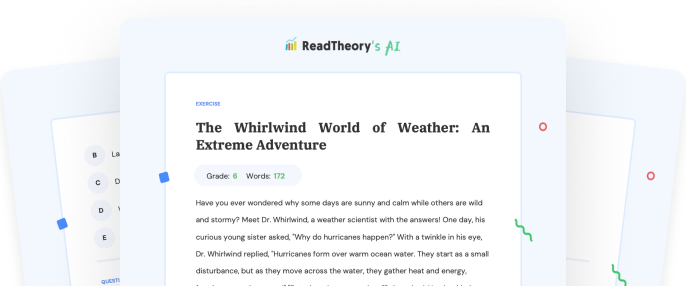Transform Your Teaching
with AI-Powered Worksheets
With ReadTheory’s Instant Worksheet Builder, you can create engaging, grade-appropriate worksheets tailored to your students in minutes. Spark curiosity, save time, and empower critical thinking with AI-powered tools designed for teachers like you.


The Multidimensional Nature of Love
Love, a simple four-letter word, is a universal sentiment that carries immense weight, yet it remains complex and multifaceted. From a scientific perspective, love triggers a cocktail of hormones in our bodies, leading to feelings of happiness, attachment, and even euphoria. From a philosophical point of view, love's nature transcends physicality. It represents a profound connection between two souls, a bond that's often inexplicable. Across various cultures and eras, love has been perceived differently, yet it invariably holds a place of reverence, signifying its vital role in human life. Literature and media have immortalized love in countless ways. From Shakespeare's timeless 'Romeo and Juliet' to Hollywood's 'The Notebook', love has been portrayed in its many shades - romantic, selfless, passionate, and tragic - influencing societal perceptions and expectations of this profound emotion. As we navigate through the labyrinth of life, love serves as a guiding light, propelling us towards growth and fulfillment.
Question 1
What does love represent from a philosophical point of view?
Physical attraction
Mutual understanding
Profound connection between two souls
Similar interests
Shared life goals
Question 2
What feeling does love trigger scientifically?
Anger
Boredom
Sadness
Happiness
Fear
Question 3
What role does love play in life according to the text?
Distraction
Source of pain
Guiding light
Barrier
Unnecessary emotion
Question 4
How has love been portrayed in literature and media?
Only as romantic
Only as selfless
Only as passionate
Only as tragic
In many shades - romantic, selfless, passionate, and tragic
Question 5
Is the statement 'Love is considered vital in human life' true or false according to the text?
True
False
Cannot be determined
Irrelevant
Not mentioned in the text
 or share via
or share via

Assign the ReadTheory pretest to determine students' reading levels.

Why Teachers Love
Instant Worksheet Builder?

Tailored Content for Every Student
Craft worksheets with passages and multiple-choice questions customized to your chosen topic and grade level, ensuring relevance and engagement.

Save Hours
of Prep Time
Our AI, Lexi, generates complete worksheets—passages, questions, and answers—in minutes, freeing you to focus on teaching, not planning.

Standards-Aligned Learning
Every worksheet is designed to boost reading comprehension and critical thinking, aligning seamlessly with State Standards to help your students shine.
Personalized teaching
for personalized learning
Browse worksheets created and refined by educators using Lexi—your source for inspiration and ready-to-use resources.


ReadTheory is free for Teachers to use.
Join thousands of educators using ReadTheory for free. Sign up today and start creating in just minutes!





